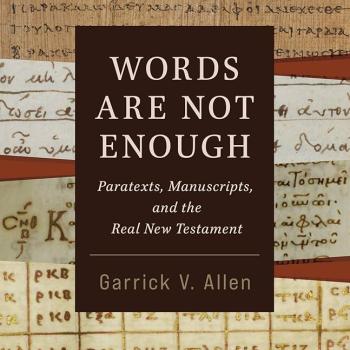 I am grateful to Eisenbrauns for sending me a free review copy of John H. Walton’s book Genesis 1 as Ancient Cosmology. This is the most recent of several books Walton has written which relate in some way to this topic. I wrote a multi-post review of Walton’s book The Lost World of Genesis One which you can read by clicking through on this link. That book was written primarily as one Evangelical to others, with Walton seeking to articulate both the content of his research and its implications specifically to those concerned about relating the Bible to science within that ecclesiastical and theological setting, who are also those with the highest potential to be attracted by unscholarly and antiscientific groups such as young-earth creationists. While Walton doesn’t take a stand on the evolution issue in Lost World, he emphasizes that such a matter is to be settled by science and not by appeal to Genesis 1.
I am grateful to Eisenbrauns for sending me a free review copy of John H. Walton’s book Genesis 1 as Ancient Cosmology. This is the most recent of several books Walton has written which relate in some way to this topic. I wrote a multi-post review of Walton’s book The Lost World of Genesis One which you can read by clicking through on this link. That book was written primarily as one Evangelical to others, with Walton seeking to articulate both the content of his research and its implications specifically to those concerned about relating the Bible to science within that ecclesiastical and theological setting, who are also those with the highest potential to be attracted by unscholarly and antiscientific groups such as young-earth creationists. While Walton doesn’t take a stand on the evolution issue in Lost World, he emphasizes that such a matter is to be settled by science and not by appeal to Genesis 1.
Those of us who appreciated Lost World also have undoubtedly looked forward to the fulfillment of his promise that that was just a taste, and that a fuller, detailed, scholarly treatment of the topic would be forthcoming. Genesis 1 as Ancient Cosmology
is the fulfillment of that promise and the end to our waiting.
In this volume, Walton provides a fuller exploration of the major points he makes more briefly for a general audience in Lost World. The claim that Genesis 1 focuses on giving function and organization to the cosmos, rather than the making of material, is given justification not only from within the Hebrew Bible, but also through the examination of a range of texts about creation from ancient Mesopotamia and Egypt.
From the very beginning, however, Walton is extremely cautious, emphasizing that he is not looking for specific texts that may have directly influenced or have been influenced by others, but exploring the cognitive environment of the creation accounts of ancient Israel. Demonstrating direct dependence is difficult, but all texts have precursors in human thought and culture, and reflect and draw their meaning from that environment even in their most distinctive features. By the end of the book, Walton will conclude that nothing in Genesis 1 is entirely without antecedent in other Ancient Near Eastern literature, and yet its precise depiction and configuration retains its distinctiveness all the same (p.197). While what we call forces of nature were closely identified by Israel’s neighbors with deities, the Israelites who composed the creation accounts in the Bible viewed things differently.
A major insight that led Walton to explore this topic was the observation that when God creates light in Genesis 1, he does not call the light “light” but rather “day.” This was a major starting point towards realizing that the focus in Genesis 1 is not the making of light itself, but the making of periods of light and dark, i.e. day and night. The focus is on function and order, not matter and other things that tend to be the focus of our own culture’s thoughts on “creation.”
In exploring Genesis 1 as ancient cosmology, Walton makes many interesting observations and suggestions. It is common to compare and contrast Enuma Elish with Genesis 1, seemingly more than any other text. And yet the element of conflict (theomachy) present in the former text is idiosyncratic, and seems to have more to do with the elevation of a new deity above more established ones than anything inherent in Ancient Near Eastern views of creation. Walton provides helpful charts to help the reader identify which themes and details are common across multiple texts.
Walton suggests (seeming to depart from his treatment in earlier works) that the raqi’a mentioned in Genesis 1:6 may in fact represent an “expanse” created by the separating of waters above and below through the placement of the solid skies or shehaqim (he also makes the case that the latter term does not denote “clouds” as is often suggested). I was not entirely persuaded, since it does not seem clear that the raqi’a and shehaqim are not synonyms or at least overlapping terms. Nevertheless, in the process of exploring this question of the precise meaning of terms, Walton provides ample evidence that the ancient Hebrews, like other ancient people, thought of the skies/heavens as solid. This is important, since those who claim to be “Biblical literalists” (including but not limited to young-earth creationists) uniformly reject the existence of a solid sky, and so this point illustrates that their alleged Biblical literalism is highly selective. Ancient Israel did not have a fundamentally different “cosmic geography” than its neighbors (pp.159-161).
For those who want to explore the contents of the book further, Jim Spinti has been sharing excerpts from the book on his blog. And so if you are not yet persuaded that this is a book that you need to buy, or at least read, then pay his blog a visit and read some quotes from Walton’s book!
I highly recommend this book, to any scholar interested in understanding the ancient Israelite view of creation in its historical and cultural context. I also highly recommend it to any Evangelical Christian interested in seeing what genuine Evangelical Biblical scholarship looks like. It is probably only through reading detailed books of this sort that those who are duped by the claims of young-earth creationism can begin to grasp the difference between real, serious, honest scholarship, and the paltry imitation peddled by folks like Ken Ham, Henry Morris, and others.












